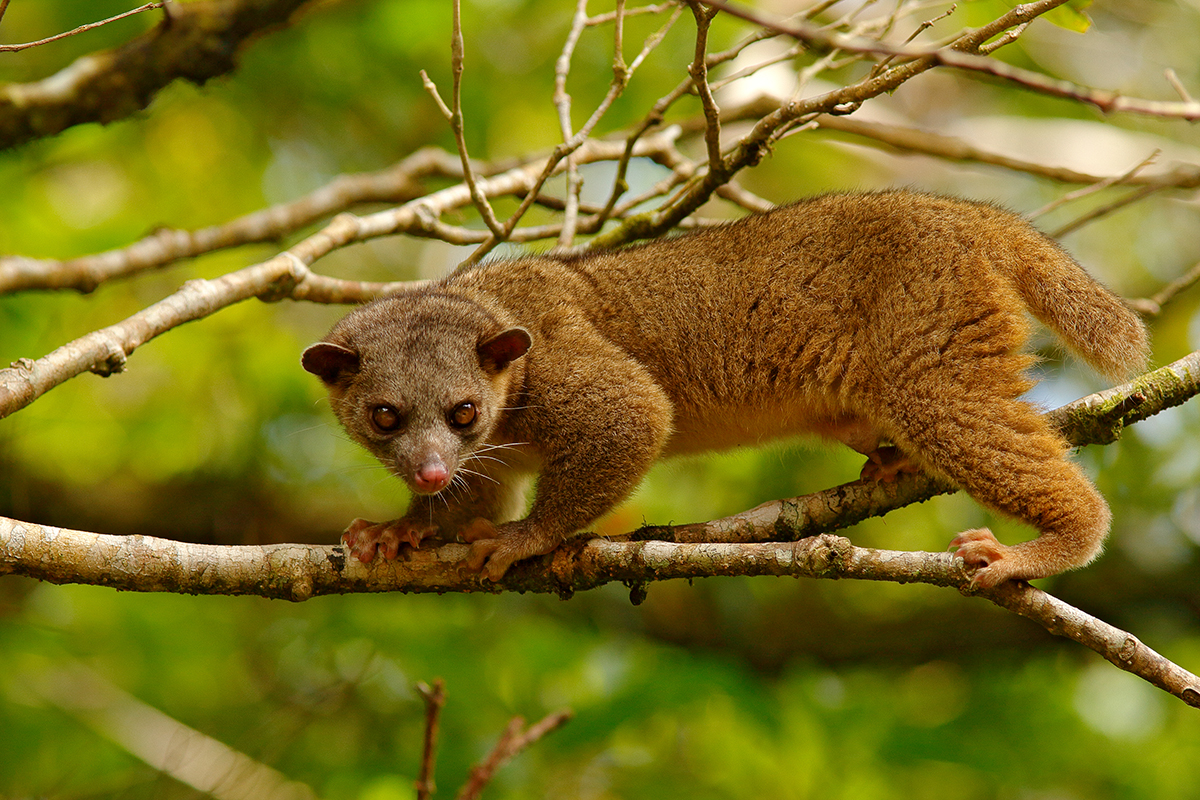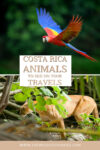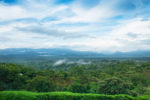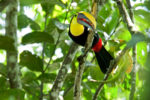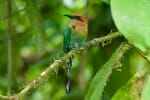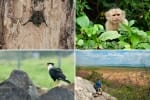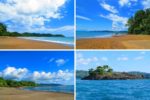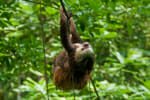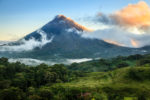Costa Rica represents only 0.03% of the earth’s surface, yet it contains more than 5% of the planet’s biodiversity. And chances are, if you are planning a trip to this nature powerhouse, you will want to see some of the fascinating Costa Rica animals.
We spent three weeks on a road trip around Costa Rica’s national parks, checking out the known wildlife hotspots and discovering new ones. This guide introduces Costa Rica animals that you have a chance of spotting in the wild on your travels.
And if you are keen to maximize your wildlife spotting opportunities it’s always a good idea to join a specialized tour like wildlife holidays with Wildfoot Travel for example.
The images in this guide are mostly the photographs I took during the trip, plus a few stock images when my photos do not show the animal well enough. Happy spotting!
Sloth – National Animal of Costa Rica
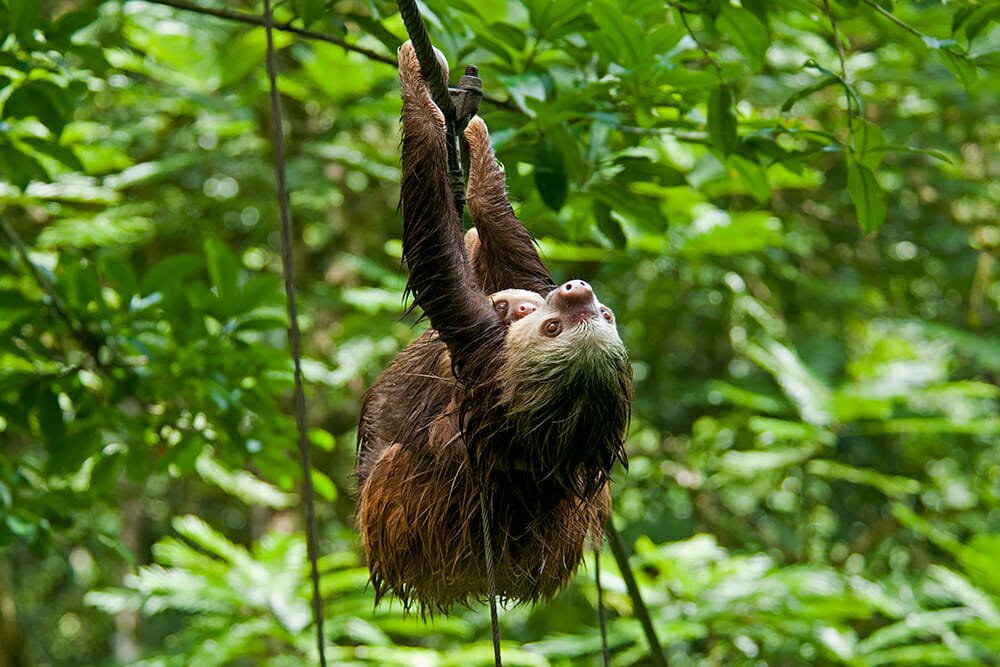
The one animal you don’t want to miss seeing in Costa Rica is the sloth. Not only is the sloth one of the most popular animals in Costa Rica, but it is also the National Animal of Costa Rica as of July 2021.
Costa Rica is home to two species of sloth: Two-toed sloth and Three-toed sloth. According to Scientific American, sloths have the slowest metabolic rate of any animal on Earth. Their diet of leaves and shoots is low in calories, and their digestion rate is the slowest among mammals. It can take a sloth up to a month to digest a meal. And since eating more is not the answer, sloths evolved to do less and conserve as much energy as they can.
These shaggy animals are so slow that algae are able to grow on their fur. As a return favour, the algae give the sloth’s fur a greenish tint that helps the animal blend with its environment and avoid predators.
Apart from the algae, a sloth’s shaggy coat is home to an entire ecosystem of invertebrates, some of which are not found anywhere else. These peculiar friendships help sloths to appear quite unappetizing to potential predators.
The two-tied sloth is the more common of the two species. You can see them on spotlighting walks virtually anywhere in the country. If you are looking for specific ideas, the Monteverde Cloud Reserve night tour is a good option.
The best place to see three-toed sloths is Manuel Antonio National Park. We found our three-toed sloth independently, but if you would like to increase your options of a successful sighting, you may like to join an organised wildlife tour in the park and mention to your guide what your focus species are.
Puma
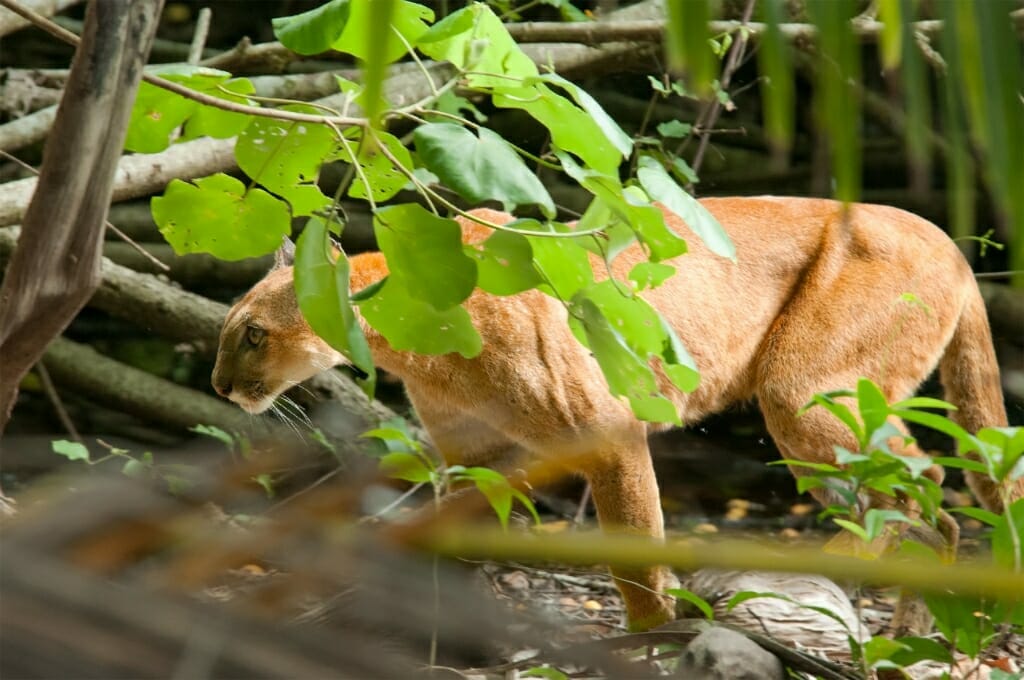
Felids are perhaps the most fascinating Costa Rica animals, but they are difficult to see in the wild. Costa Rica is home to six wild cat species: jaguar, puma, ocelot, jaguarundi, margay, and oncilla. Your best chance of encountering a wild cat in Costa Rica would be spotting a puma in Corcovado National Park.
Puma is the second-largest cat in Costa Rica, and it is widely distributed across the county. However, the best place to try your luck with pumas is Corcovado National Park. There is a trail in Corcovado that runs between Serena and La Leona Ranger stations and goes through the picturesque Puma Valley, and this is where pumas are occasionally observed.
We were lucky to encounter a female puma with two juvenile cubs in Puma Valley in 2015. You can find more images and details about our encounter in my trip report from Corcovado.
Visiting Corcovado is one of the wildest adventures in Costa Rica. The park can only be visited with a certified nature guide. For a hustle-free option, there are Corcovado tours departing from San Jose. And for more intrepid adventurers there are also tours that depart from Drake Bay.
White-faced capuchin
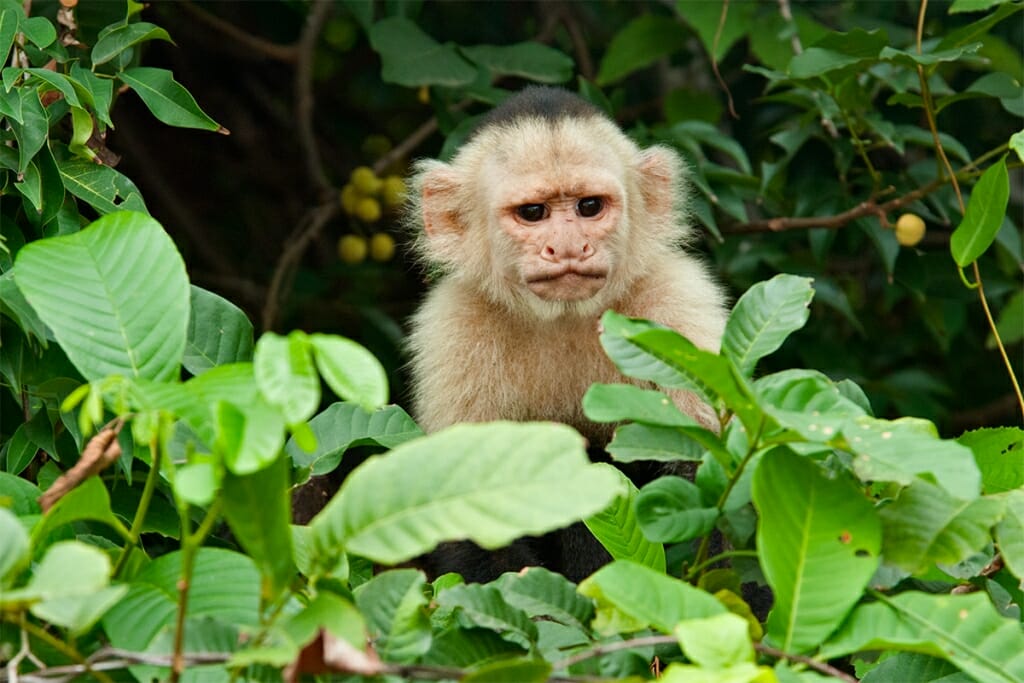
Primates are much easier to see in Costa Rica than wild cats. Of the four Costa Rica monkeys, the White-faced capuchins are perhaps the cheekiest and most comfortable around people. Too comfortable at times.
You can see white-faced capuchins in most national parks. River cruises are generally best for up-close-and-personal encounters with them since water acts as a natural barrier and animals feel safer. A cruise in Palo Verde National or around Damas Island are some of the best I’ve done.
Central American Squirrel monkey
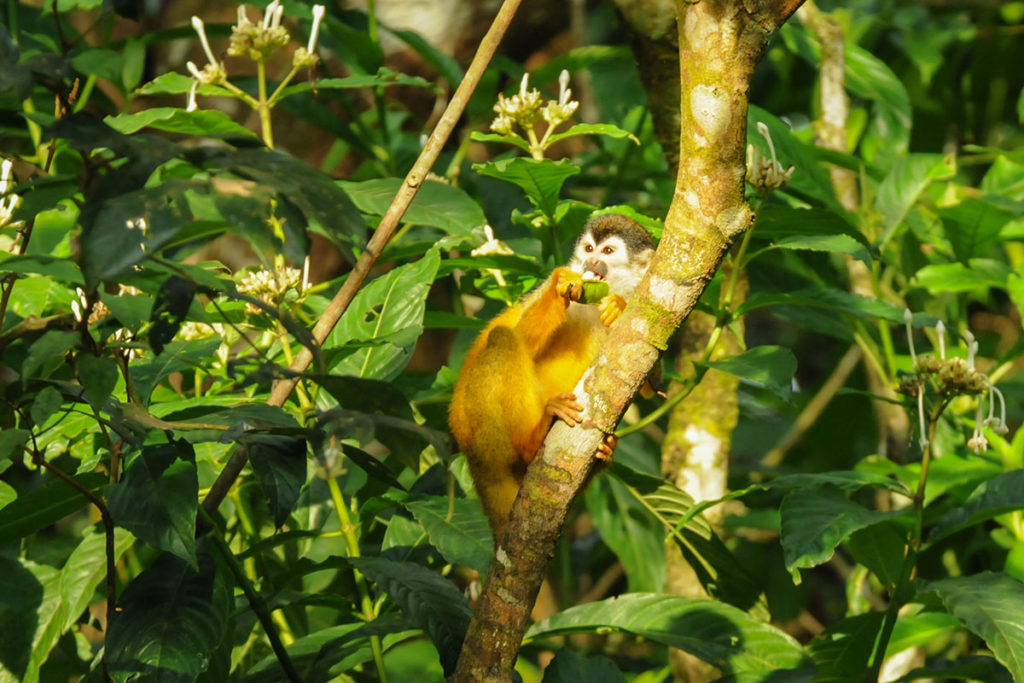
The Central American squirrel monkeys are the most adorable primates in the Costa Rican jungle. These social monkeys prefer to live in large groups and can often be heard as they move through the forest, squeaking and chirping along the way.
Their good looks and cartoonish demeanour are one of the reasons the species is in decline – they are very popular in the exotic pet trade. In Costa Rica, you can see squirrel monkeys in several national parks, including Corcovado and Manuel Antonio.
A curious fact about squirrel monkeys in Costa Rica is that they have different breeding seasons in different areas. According to Costa Rica’s tourism board squirrel monkeys in Manuel Antonio give birth at a different time than those in Corcovado.
Howler monkey
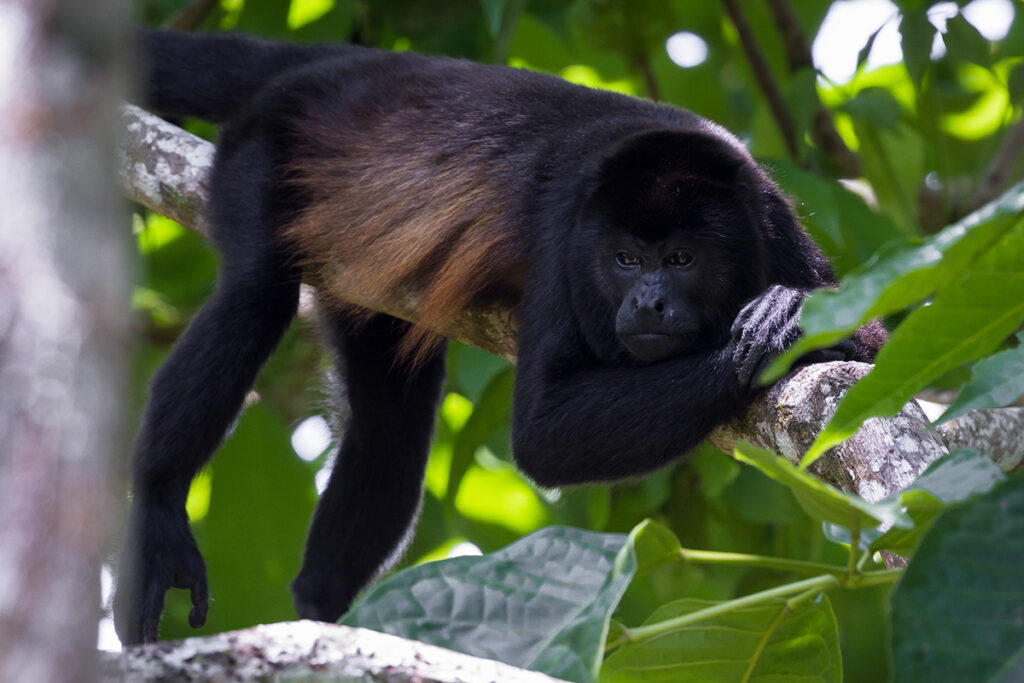
The howlers are the most commonly encountered monkeys in Costa Rica. You can spot them even on resort grounds. Most often, you’ll hear them before you see them. Their calls can be heard up to three miles away in the dense forest. In fact, howler monkeys are considered to be the loudest terrestrial mammals in the western hemisphere.
They live in groups of 4 to 19 individuals, and each group has its own territory. At dawn and dusk, the males erupt in deep guttural calls that sound more like a big cat than a small primate.
Black-handed spider monkeys
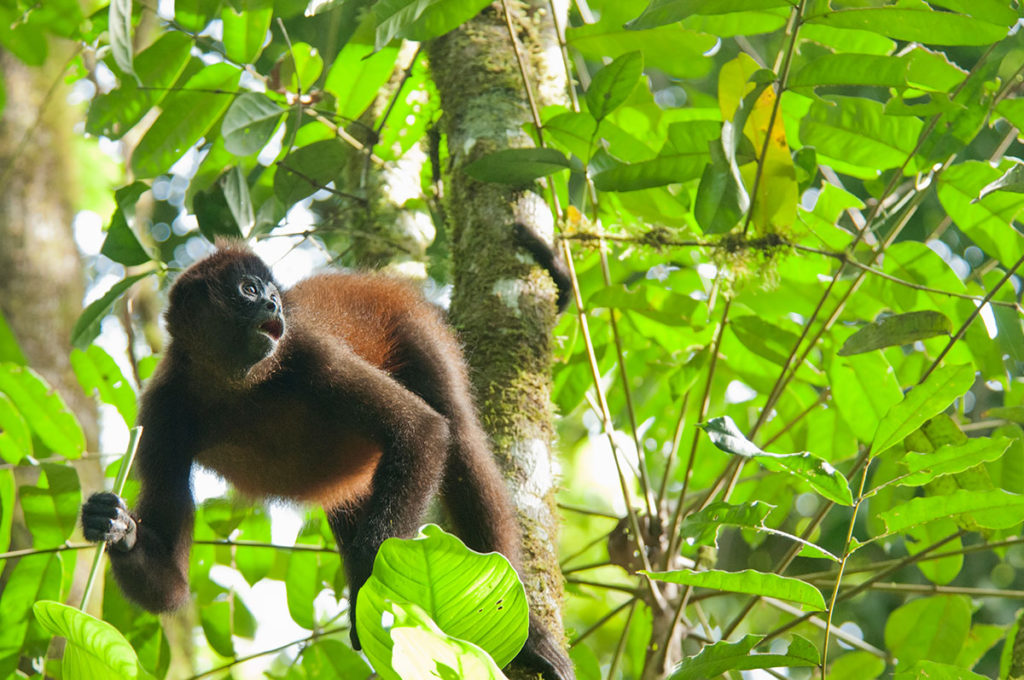
Famously dexterous, spider monkeys have extremely long limbs and a prehensile tail that functions as a fifth limb. They hang effortlessly from the branches using their hands to rip open the ripe fruit and gorge themselves on the soft and sugary inner parts.
The spider monkeys are some of the rarest of Costa Rica animals. They are among the world’s 25 most endangered primates. The spider monkeys’ preference for large areas of primary forest makes them particularly sensitive to habitat loss.
The best place to see Black-handed spider monkeys, and the only place to see all 4 of Costa Rica’s monkeys, is Corcovado National Park on the remote Osa Peninsula.
Baird’s Tapir
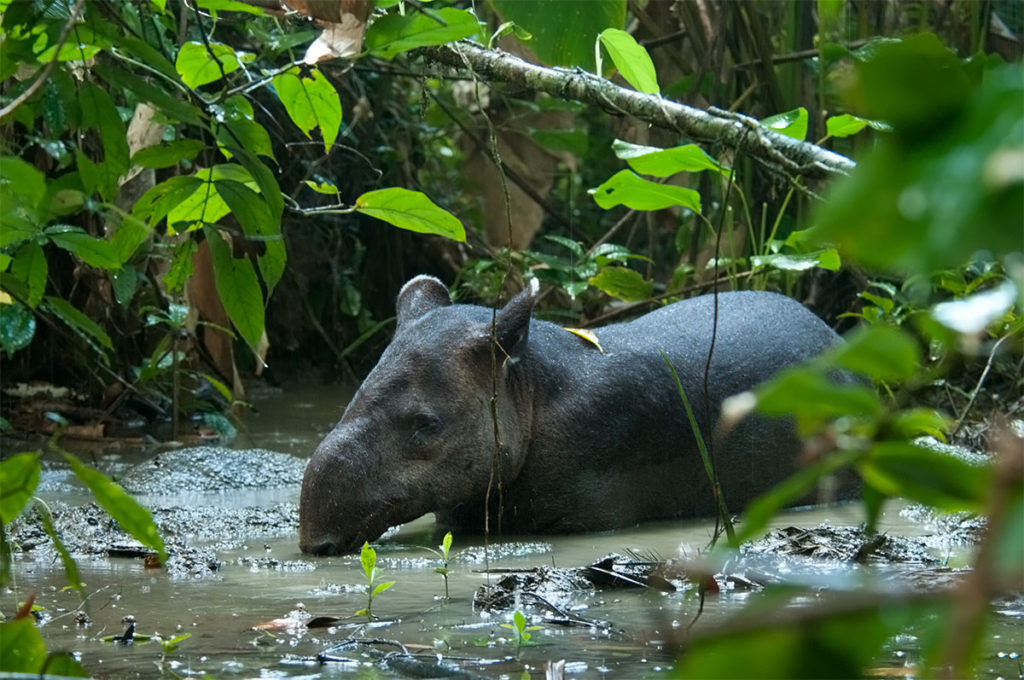
Corcovado is also the best place to see Baird’s tapir. These gentle creatures are fond of snoozing in shaded puddles in the park, and early in the morning, they often take a dip in the ocean.
Baird’s tapir is the largest of the three species of tapir native to the Americas and the largest native land mammal in Central America. Despite having a prominent proboscis, or tube-like nose, tapirs are not related to elephants. Their closest relatives are horses and cows.
Like all tapir species, Baird’s tapirs are in decline. They are currently listed as Endangered on the IUCN Red List of Threatened Species.
Kinkajou
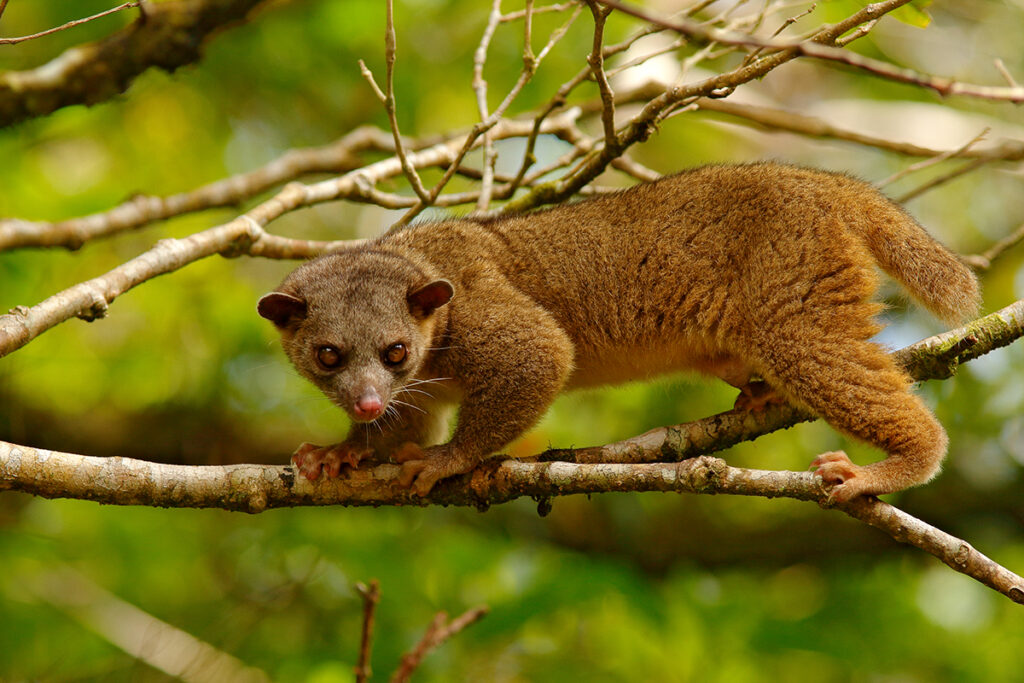
Looking like something between a golden-coloured monkey and a weasel, Kinkajou is neither. It is closely related to olingo, raccoons and coatis. The name ‘Kinkajou’ means ‘honey bear’, referring to the animal’s fondness for raiding beehives to feed on honey.
Apart from honey, Kinkajou feeds mainly on fruit. Our only sighting of Kinkajou was at night when we were having dinner on the balcony of our rental house in Quepos. We heard rustling among the branches of a mango tree and found a Kinkajou snacking on ripe mangos.
Olingo
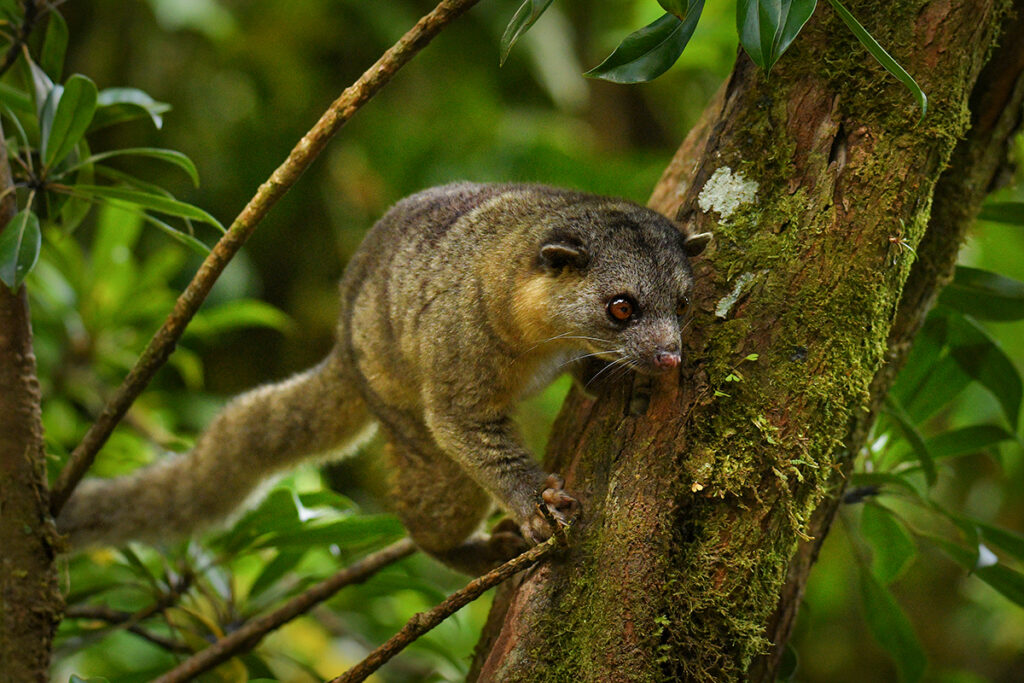
Looking similar to Kinkajou, the Olingo is a nocturnal arboreal mammal that belongs to the raccoon family. The best place to see the olingo is the Hummingbird Gallery located just outside the entrance to Monteverde Cloud Forest Biological Preserve. They come to feed on the nectar from hummingbird feeders.
For the best chance of seeing the olingo, time your visit to the gallery so that you arrive late in the afternoon and stay until the place closes. It didn’t show on the day we visited, but when it does, it climes down the feeder like an acrobat and laps up the nectar while hanging upside-down.
Tamandua
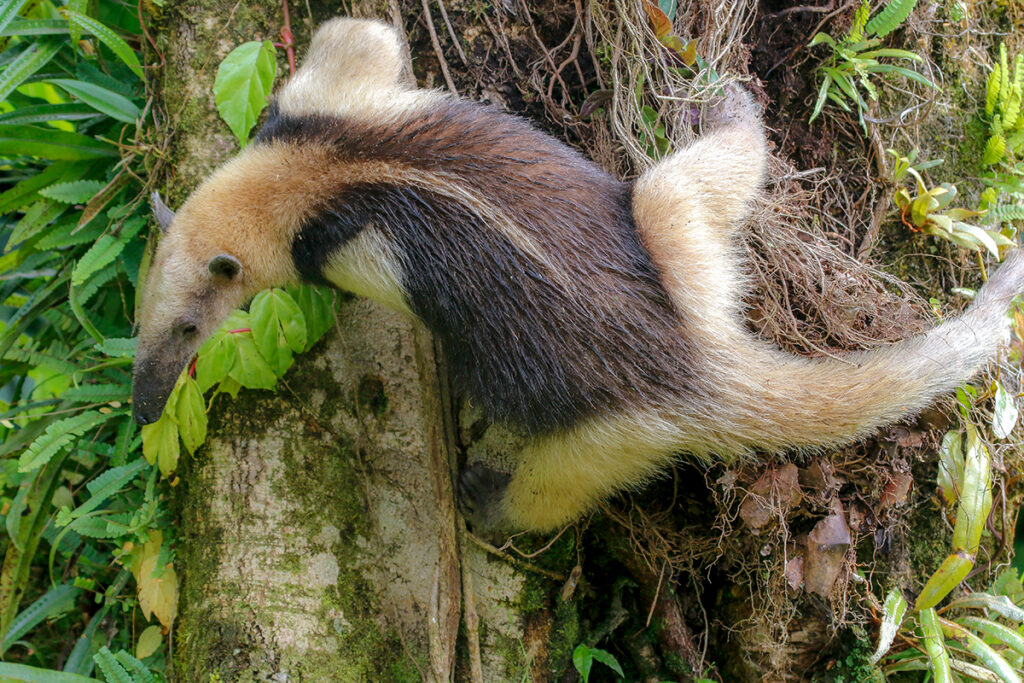
The Northern Tamandua is also known as a lesser anteater due to being a smaller animal than the giant anteater. Like all anteaters, tamandua feeds exclusively on ants and termites. And unlike its giant relative, Northern tamandua is mostly arboreal. It spends most of the day curled up in its nest, often in a tree hollow, and forages mostly at night.
You may smell the tamandua before you see it – it has quite an unpleasant odour, reportedly four times more pungent than that of a skunk. So make sure not to frighten it if you spot it on your travels.
Despite their mostly nocturnal habits, tamandua are often seen during the day. They are more common at lower elevations. We saw a northern tamandua high in the jungle canopy in Corcovado National Park.
Silky Anteater
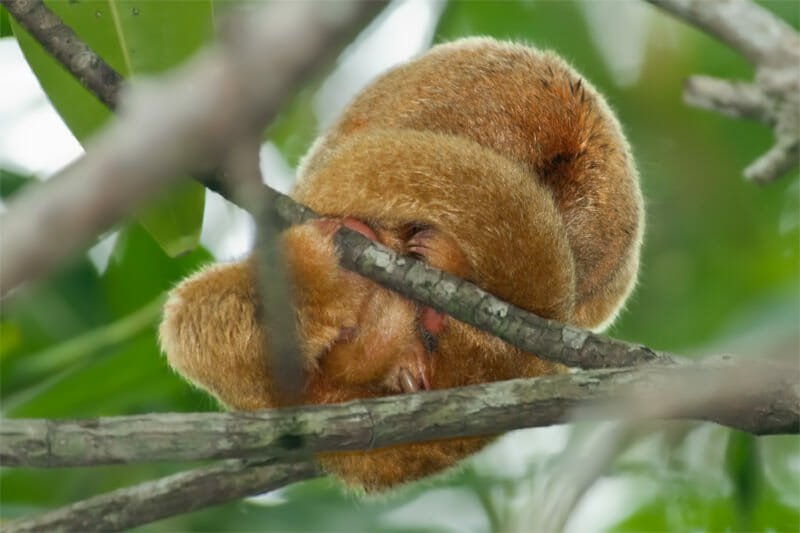
Even smaller than the tamandua, the Silky anteater weighs between 200 and 400 grams. It is one of the trickier animals to spot, but in Costa Rica, you can see Silky anteaters on Damas Island.
These tiny anteaters are strictly nocturnal, so when you do spot them during the day, you will likely find them fast asleep, curled in a ball. The way to visit Damas island is to book a boat cruise and look for animals from the boat.
Opossums
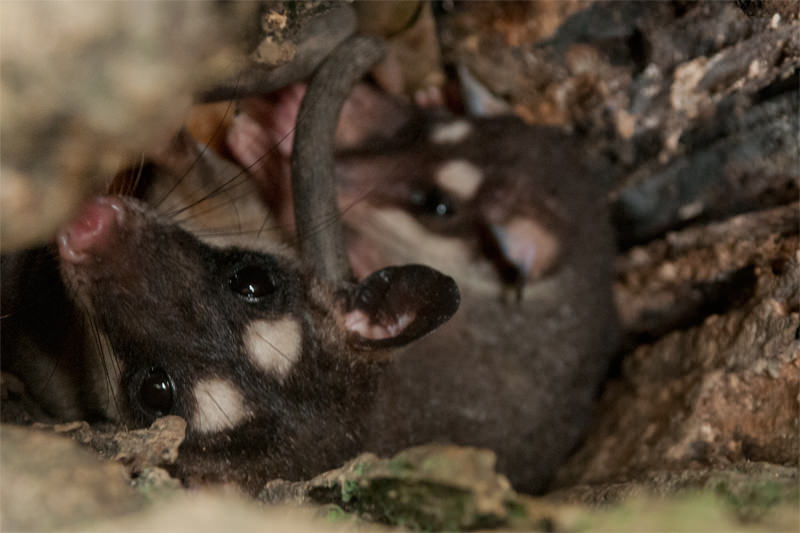
Another nocturnal species you might see on Damas Island is the Gray Four-eyed opposum. These opossums have a grey coat with white spots above the eyes, which gives them the appearance of having four eyes.
Another commonly-encountered opossum is the Wooly opossum. Both species are nocturnal, so you’ll either find them snoozing in a tree hollow during the day or browsing at night if you take a spotlighting walk. We saw the Wooly opossum on a night walk at La Selva Biological Station, and the Four-eyed opossum snuggled up with her young in the hollow of a broken-off tree trunk on the riverbank on Damas Island.
Mexican dwarf porcupine
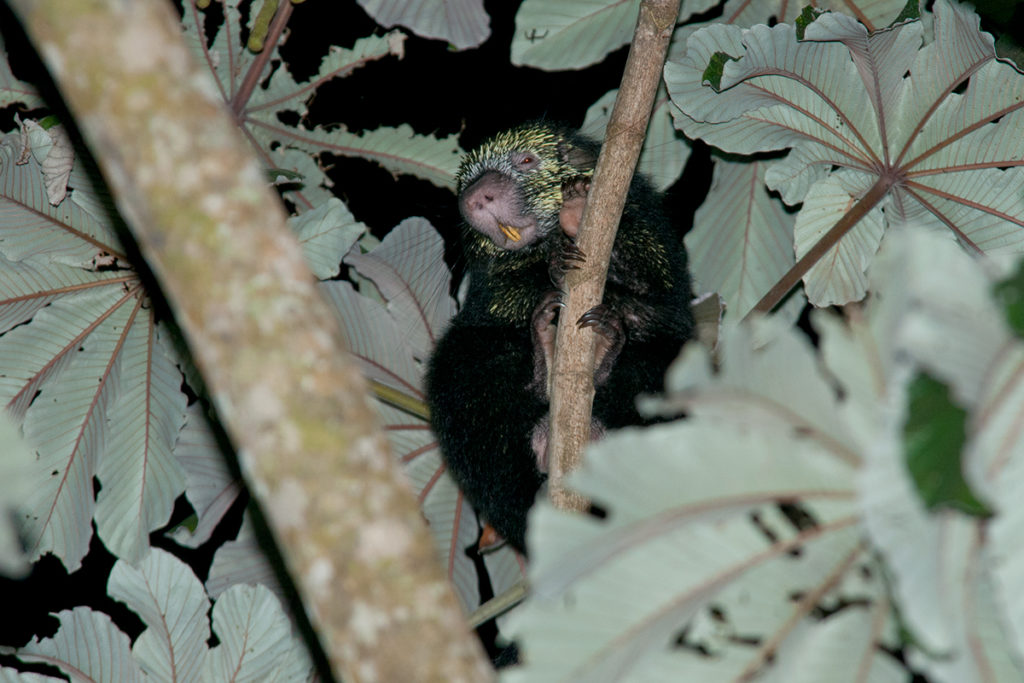
The Mexican dwarf porcupine is a very curious creature. Unlike Asia’s porcupines which appear to be rather clumsy and live on the ground, the Mexican porcupine is an agile climber with a prehensile tail. Also, unlike the impressive quills of terrestrial porcupines, the spines of the Mexican porcupine are short and only visible on its head. The rest of the spines are covered with long black fur on its body.
Spotlighting walks in Monteverde give you a good chance of spotting the dwarf porcupine, as do night walks at La Selva Biological Station in Heredia.
White-nosed Coati
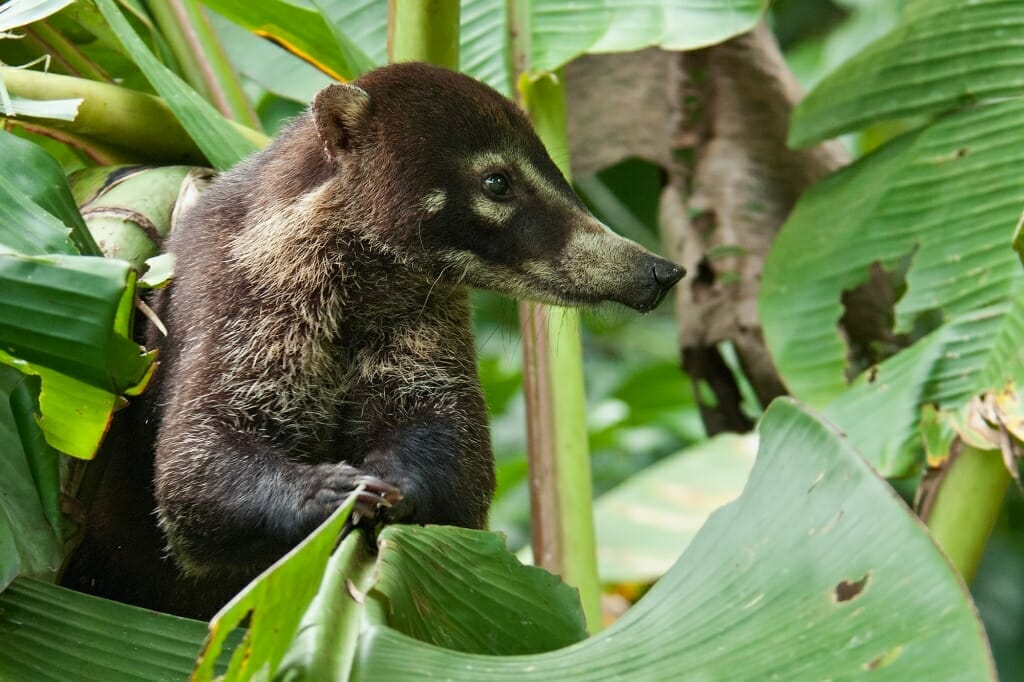
Here is an animal that needs no introduction. The Coati is one of the most commonly encountered animals in Costa Rica.
If you see a solitary coati, it is most likely an adult male. Female coatis and young males live in social groups of 4-20 related and unrelated individuals. This social segregation lead early scientists to believe that male coatis were a separate species. They were named coatimundi, which means “lone coati” in Guarani, a native language in Paraguay.
We found that the lone male coatis are much easier to see in Costa Rica. There is one usually hanging at a parking lot in most national parks.
The best place to see coati groups is Corcovado National Park. Like many animals in Corcovado, coatis are quite nonchalant around humans and it is not uncommon to find yourself surrounded by a group of browsing coatis as the dig for mushrooms and insects along the jungle trails.
Collared Peccary
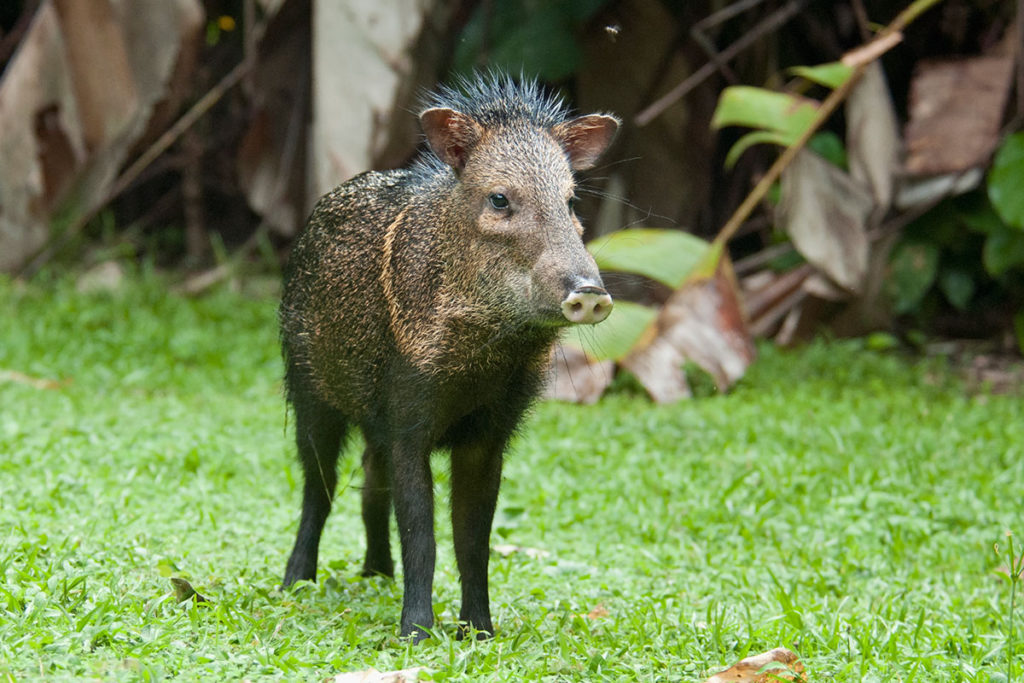
Collared peccaries may look a lot like pigs but they belong to their own – peccary family. They are social animals that travel in noisy groups, constantly communicating with one another. So you will probably hear them before you see them.
You may also catch a whiff of their musty scent, which also helps group members identify each other.
They are considered very common in Costa Rica, but we only saw them in Corcovado National Park.
Honduran White Bats
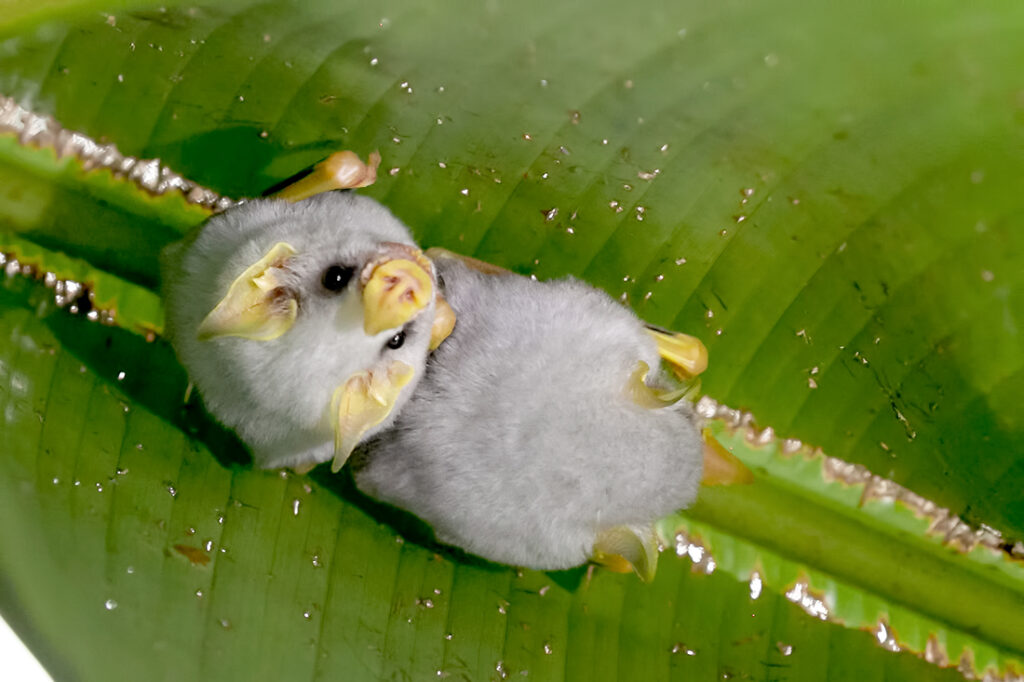
The Honduran white bat, also known as the Caribbean white tent-making bat, is the most handsome of all tent-making bats and one of the cutest Costa Rica animals. These curious bats build their own shelter by biting the central vein of a large banana leaf until it folds in half, forming a V-shaped shelter that protects the bats from the sun and the rain.
White Honduran bats were very high on our bucket list so we made a special effort to find them. Tirimbina Reserve used to be the place to see them until floods destroyed the patch of Heliconia where they used to roost. If you are keen on seeing them, book a trip from Tirimbina to La Selva Biological Station nearby.
Brazilian long-nosed bats
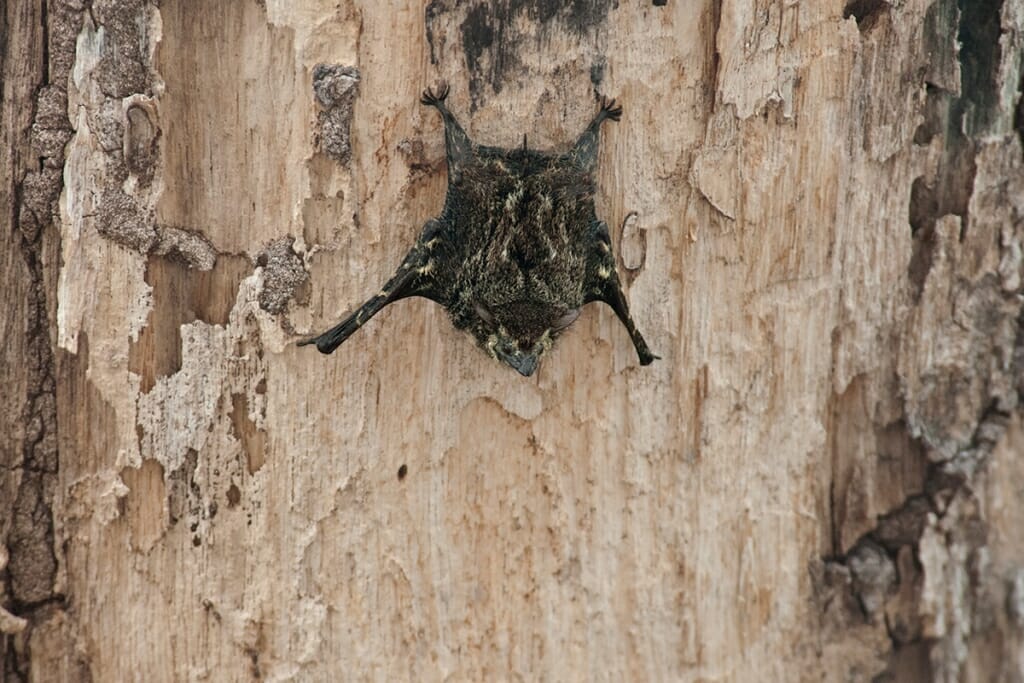
Brazilian long-nosed bats are another cool species of bats to see in Costa Rica. Like all bats, they are nocturnal animals. During the day they roost in rock crevices or on tree trunks near rivers, ponds, and lakes because they prefer to feed on slow-moving insects that live on the surfaces of water bodies.
Because they often roost on exposed surfaces, like tree trunks, they developed a cool predator avoidance technique. They arrange themselves into a neat vertical row and, when threatened, they start swaying back and forth synchronously, making themselves look like a moving snake.
The absolute best place to see Brazilian long-nosed bats is Palo Verde National Park. Take a boat tour in the park and you’ll see the bats roosting on tree trunks rising out of the river.
Humpback whale
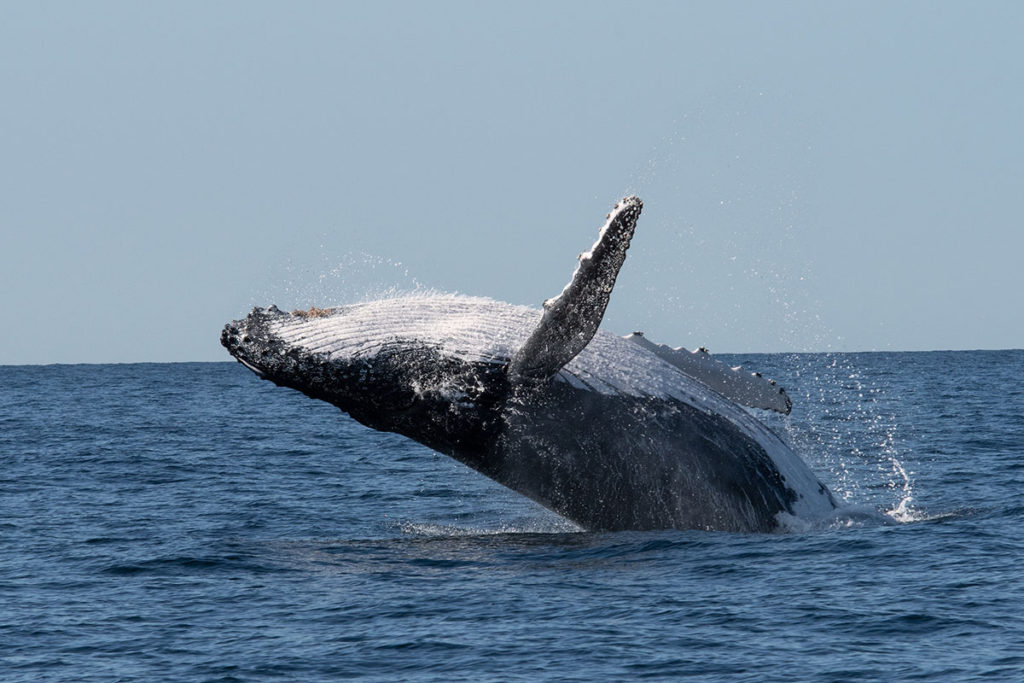
Costa Rica is a fantastic place for seeing Humpback whales. Each year they migrate from their feeding grounds in Antarctica to the warm waters off Costa Rica’s coast to give birth to their young.
Humpback calves weigh about two tonnes at birth and each day they consume up to 600 litres of mother’s milk, which contains a whopping 60 per cent fat.
The newborn calves need all the nutrition they can get. Their main job is to fatten up quickly for their first journey to Antarctica or towards the Arctic Circle in a few months’ time. And Costa Rica’s protected marine areas give them a safe place to prepare for the journey.
We saw Humpback mum and bub on a whale-watching cruise from Drake Bay. Osa Peninsula, in general, is the most popular whale-watching destination in Costa Rica. But the laid-back town of Drake Bay is peaceful and quiet, don’t worry about encountering crowds of tourists here.
Resplendent Quetzal
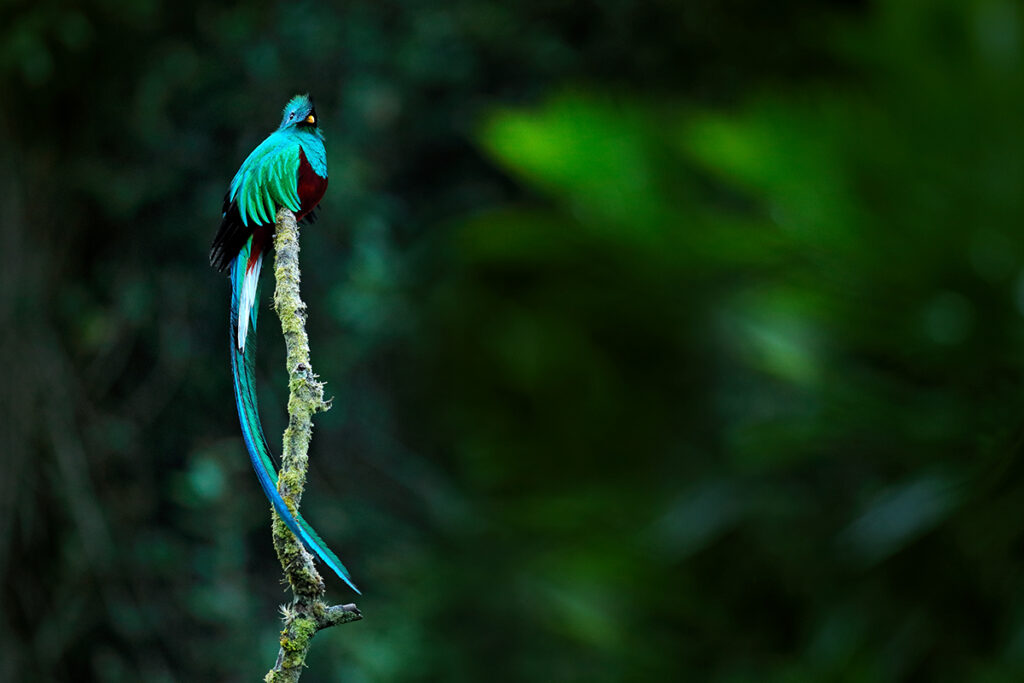
The Resplendent Quetzal is probably the most famous bird in Costa Rica. And for good reason – the bird is absolutely spectacular. It belongs to the Trogon family and it is the most iridescently coloured of all trogons. Male quetzals are more brilliantly coloured than females and their brilliant plumage is complemented by exquisitely-long tails.
Monteverde Cloud Forest Reserve is considered one of the best places for seeing quetzal in Costa Rica. However, as hard as we tried, we could spot one. If you are really keen to see a quetzal, and you should be, a bird-watching tour in Monteverde will increase your chances.
Toucans and Aracaris
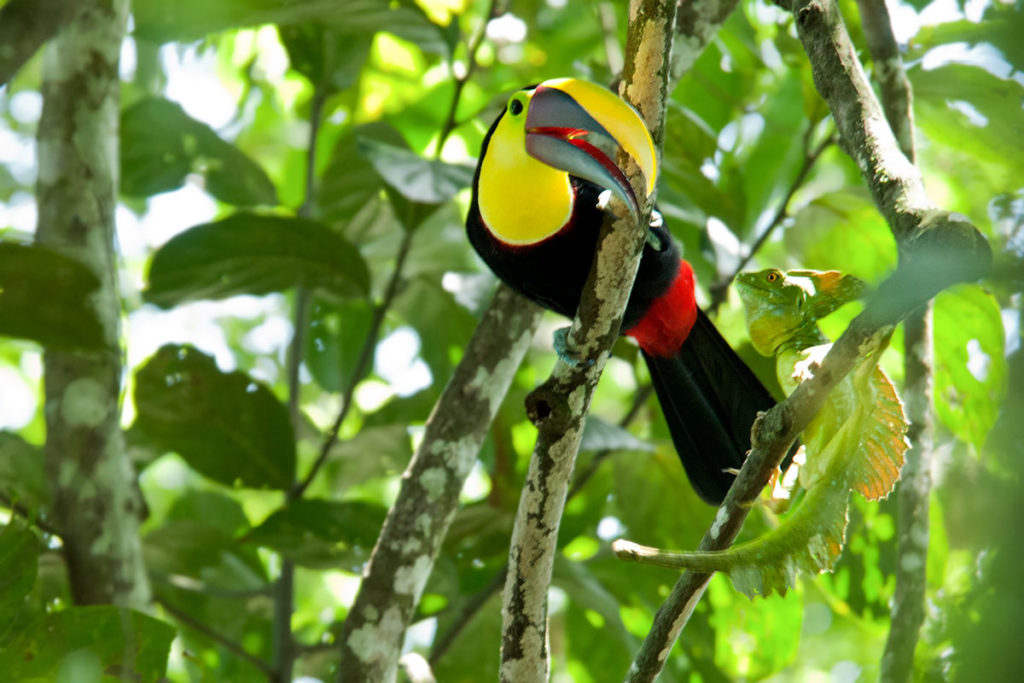
The toucan family in Costa Rica is represented by several species of toucans and aracaris. All birds in this family feature spectacularly oversized and often colourful beaks.
It is not known exactly why these birds evolved to have such an extravagant appendage, but one of its benefits is the all-important energy conservation. Feeding primarily on fruit, the toucans can park themselves in a fruiting tree and reach the faraway fruit from their perch without the need of hopping around.
The most striking toucan in Costa Rica is the Keel-billed toucan. Good places to see them are Tirimbina Reserve and Corcovado National Park. The somewhat more frequently encountered are Yellow-throated toucans.
I found Tirimbina Reserve to be the best place for spotting both species of toucans and Collaraed aracaris. One Yellow-throated toucan I was watching seemed to be a little restless on its perch, but I couldn’t see what was aggravating it. Only when I looked at my photos (see above) I noticed a very well-camouflaged Green iguana sitting on a neighbouring branch.
Scarlet Macaw
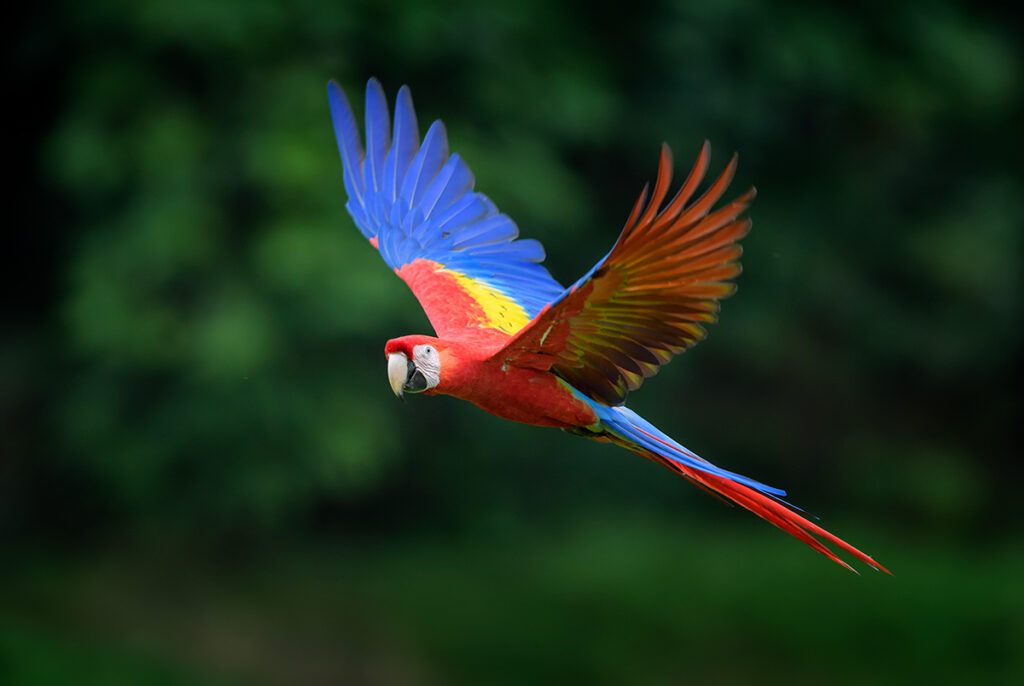
I have a soft spot for parrots, and Costa Rica’s most spectacular parrots are the Scarlet macaws. Visually striking and quite vocal, the macaws are not difficult to see in Costa Rica. They are social birds and usually move about in noisy flocks.
While you have a good chance of seeing them almost anywhere along Costa Rica’s Pacific coastline, we’ve seen more Scarlet macaws in Drake Bay and Corcovado National Park than anywhere else. Palo Verde National Park is another good place to see them.
On the Caribbean slopes, you have a good chance of finding Costa Rica’s other macaw species – The Great Green Macaw. Head to Tortuguero National Park for the best chance of spotting them.
Hummingbirds
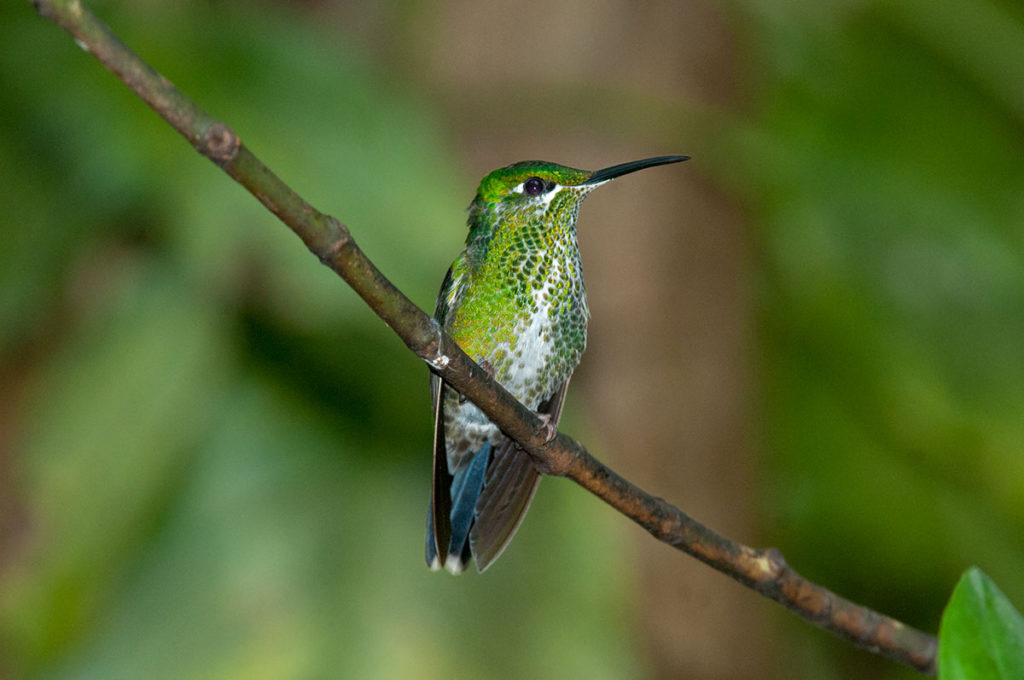
Hummingbirds are not the easiest birds to see, or at least to see well in the wild. But there is a very special place in Costa Rica where you can stand surrounded by dozens upon dozens of these tiny brilliantly coloured birds that beat their wings too fast for a human eye to see.
This place is the Hummingbird Gallery – a small courtyard of the Wildlife Photography Gallery & Souvenir Shop next to the entrance of Monteverde Cloud Forest Biological Preserve.
There are 14 different species of hummingbirds that visit the gallery, although we were only able to identify half a dozen of them. We saw: Violet saberwing, Green-crowned brilliant, Stripe-tailed hummingbird, Coppery-headed emerald, Purple-throated mountain gem, Steely-vented hummingbird, Green violet-ear and a few Bananaquits. The hummingbird gallery is one of the most captivating wildlife experiences in Costa Rica.
Crocodile
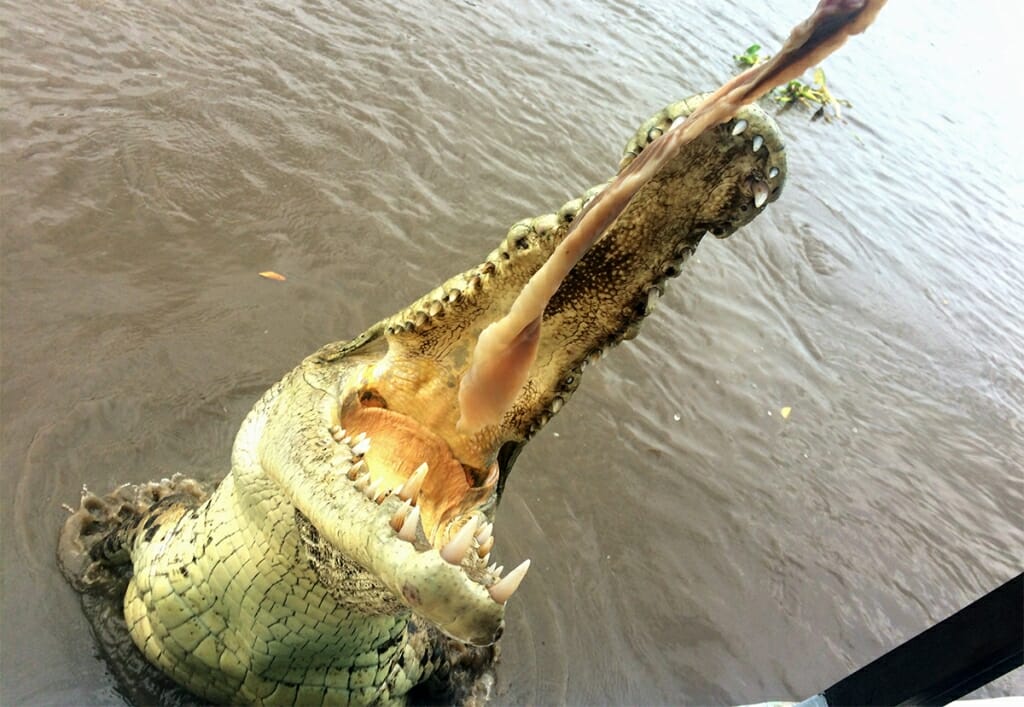
I bet crocodiles don’t come to mind when you think about Costa Rica animals. But there are plenty of opportunities to see American crocodiles in the country. The best way to see them is from a boat. We’ve seen crocs on boat cruises in Palo Verde National Park and around Damas Island. But you don’t even need to be in a national park to see these amazing reptiles. A boat trip from Sierpe to Drake Bay is sure to turn up a few.
Despite their menacing appearance, American crocodiles are not considered particularly dangerous. Our guide in Corcovado led us across the river, wading through the water up to our thighs, while a submerged crocodile was floating just a few meters downstream. And while our guide was quite relaxed, this was one of the quickest river crossings of our trip!
Eyelash pit viper
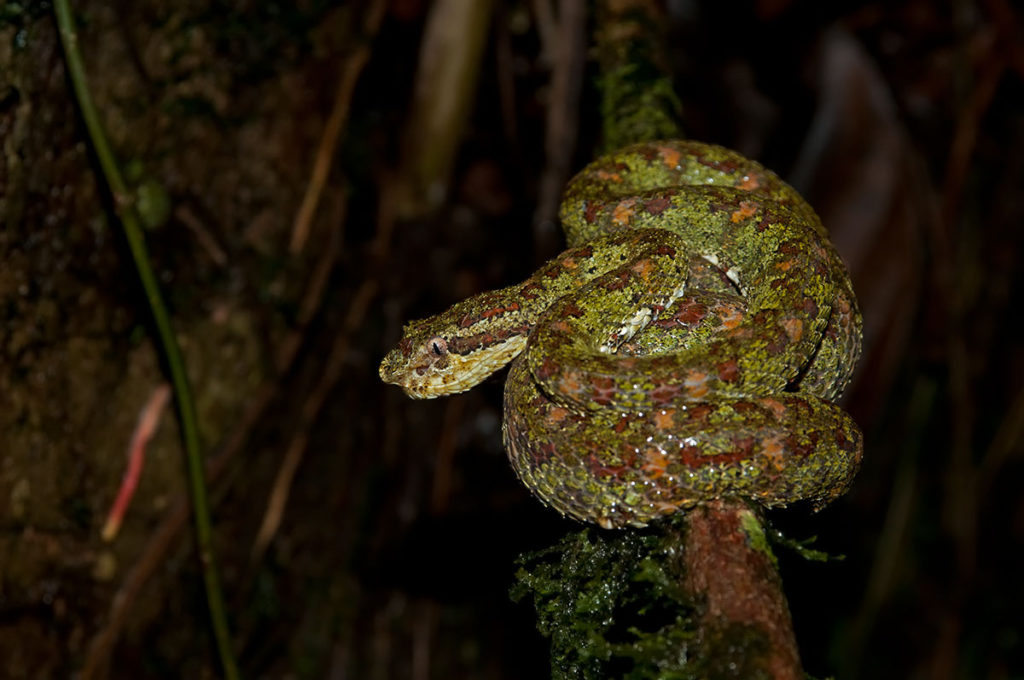
Named for the bristly scales above its eyes, Eyelash pit viper is one of the smallest venomous snakes in Central America. Typically a small snake wouldn’t be too easy to see, yet in Costa Rica, typical rules don’t apply.
We saw our first Eyelash pit viper on a spotlighting walk in Monteverde. But our second sighting was much more interesting.
While hiking the trails in Corcovado National Park, our guide pointed out the little viper curled up on a branch by the side of the trail, perfectly camouflaged against the moss-covered bark. It turned out, she could be found there any day, frozen motionless for hours, waiting for unwary prey to approach within her striking distance.
Fer de lance
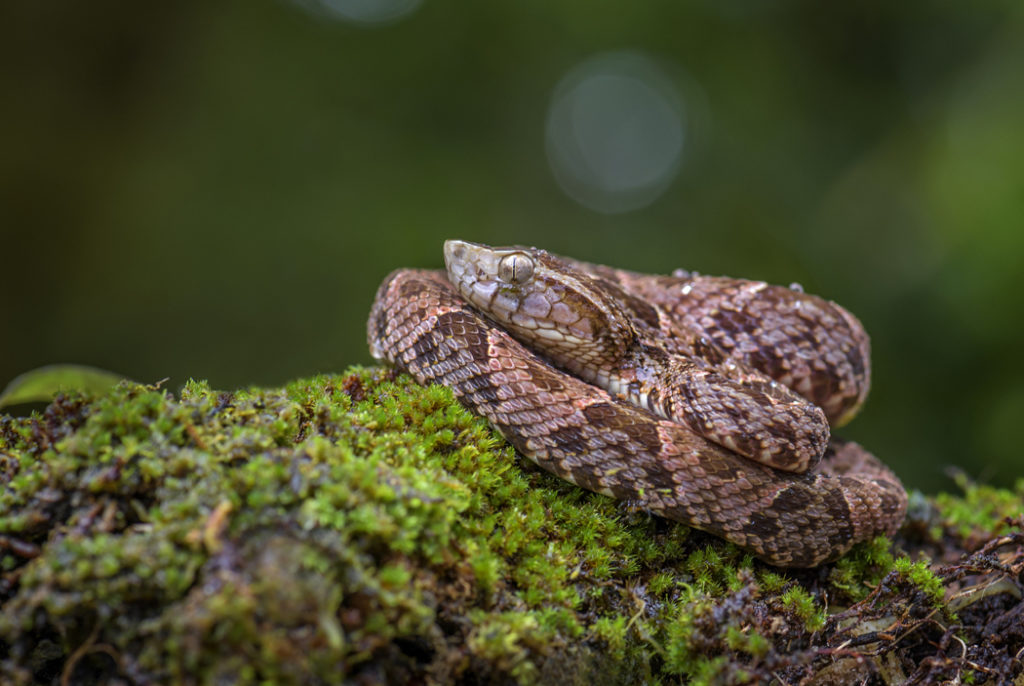
Fer-de-lance also belongs to the Viper family, but you’ll want to be careful around this one. It is South America’s most dangerous snake. This aggressive viper is responsible for most snakebite-related deaths among humans in the region.
Our encounter with a Fer-de-lance happened on our last morning in Corcovado. We were already packed and ready to go when one of the guides tipped our guide that his group just saw a Fer-de-lance.
Not wanting to miss our boat we trotted after the two guides into the forest. And because Corcovado trails are extraordinarily muddy and we were wearing flip-flops, we ended up running barefoot. To see the country’s most deadly creature.
When we arrived at the right spot – the guide had to point out the snake – it was curled up on the forest floor, a mere few meters away from the trail, perfectly camouflaged among the leaf litter. It was virtually indistinguishable from the leaf litter. For such a dangerous creature to be all but invisible, you understand how humans may inadvertently come in close contact with it.
Mangrove Boa
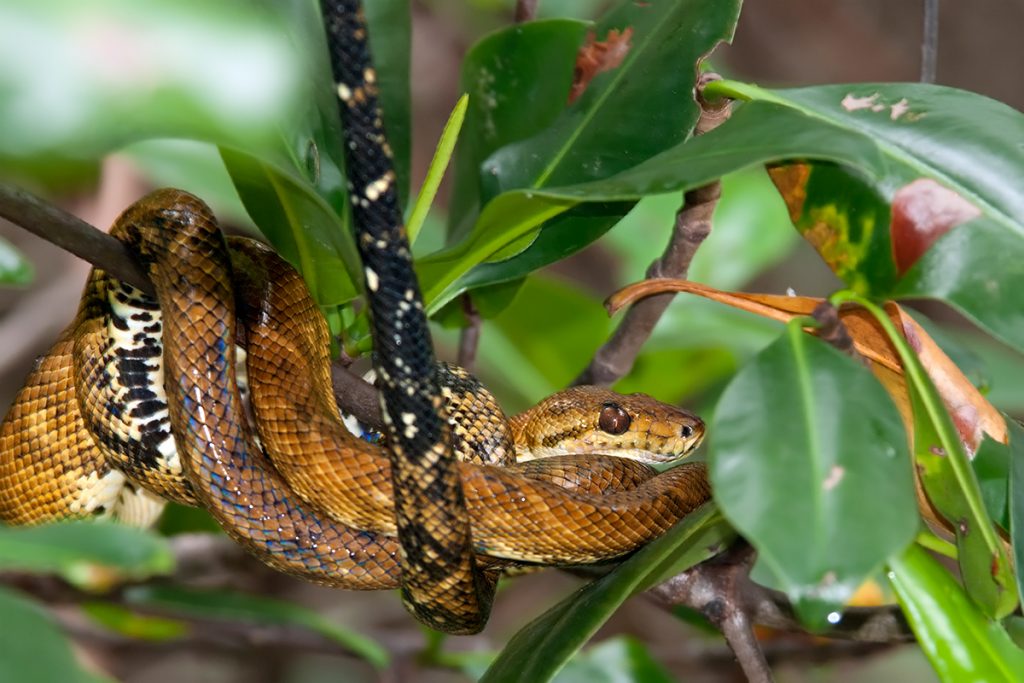
In contrast to the two small but venomous vipers, the Mangrove boa is a large but harmless snake. As its name suggests, the Mangrove boa is found in the mangroves, but also in riparian forests, lowland forests, tree-lined savanna, and palm groves where it feeds on rodents and other small mammals.
We came across a Mangrove boa on a boat cruise at Damas Island. It was curled up on a tree branch with its tail stretched about half a meter up, clinging to a different branch above.
Green Iguana
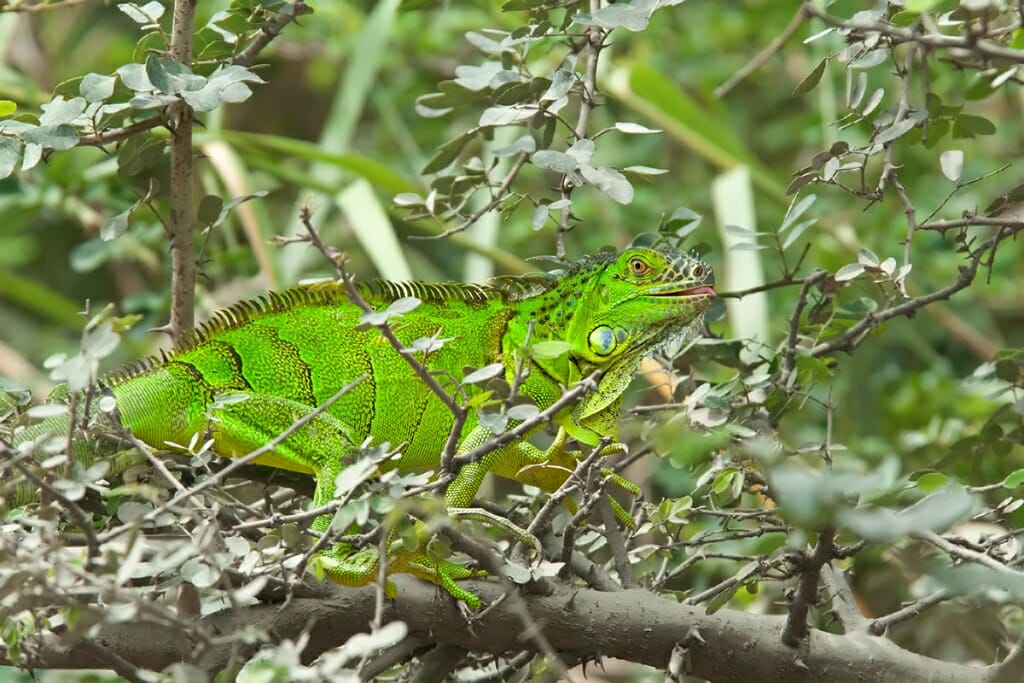
Of all the reptiles in Costa Rica, you’ll have no trouble spotting Green iguanas. You’ll probably have a few living on your hotel grounds. The more naturalistic setting to see iguanas are the riverbanks. So boat tours are great for seeing them.
The Green iguana is the largest lizard in the Americas, but not all individuals you see will be huge. Some of the largest iguanas we saw were in Palo Verde National Park and, surprisingly in the town of Quepos on Boca Vieja creek.
Poison Dart Frogs
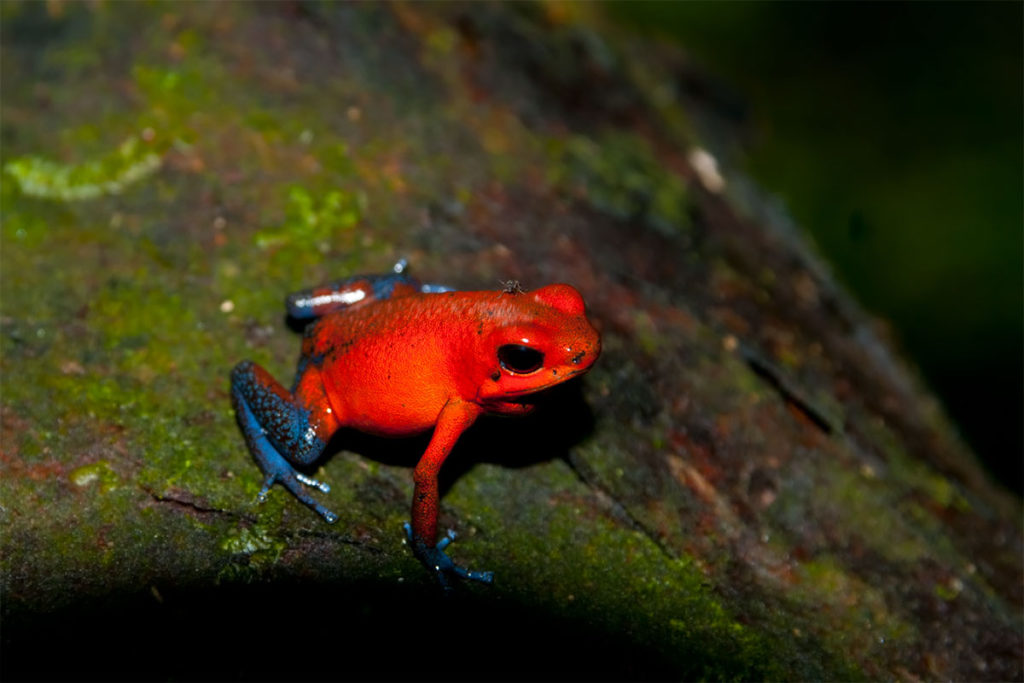
The first thing that surprises you about poison dart frogs is how tiny they are. The Strawberry poison dart frogs or Blue Jeans, that we discovered in the garden beds at Tirimbina Reserve were about the size of my thumbnail.
You would think it would be easy to see a frog with the vividly red body and bright blue legs among the brown leaf litter, but these guys are so small, it took some serious effort to locate them at first. Once we knew what we were looking for, we soon became experts at finding them.
On Tirimbina trails you can also find green-and-black poison dart frogs. They are not as colorful as strawberry frogs, but just as striking, and as small.
Red-eye Tree Frog
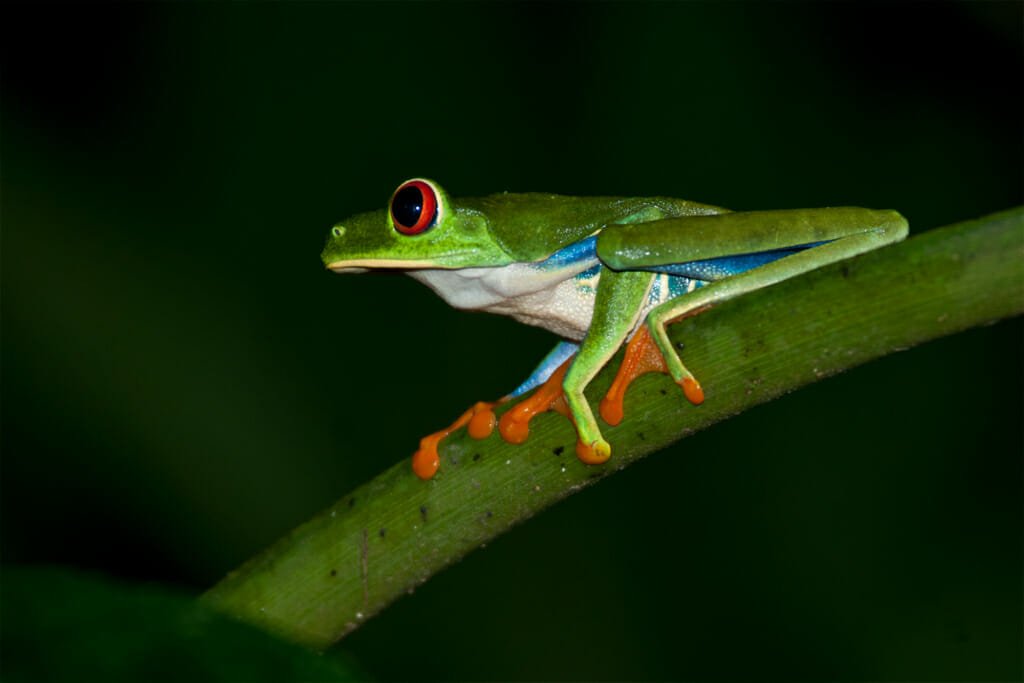
Almost all continents seem to have Red-eyed tree frogs. There are red-eyed tree frog in Australia, in Borneo, and of course, in Costa Rica’s ancient forests.
Costa Rica’s Red-eye tree frog is one of country’s most iconic animals. It lime green body with blue and yellow striped flanks and its huge red eyes are instantly recognizable.
To see them, you’ll need to book an organized night walk. Drake Bay night tour is a great option. We’ve seen Green-eyed tree frogs, and dozens of other frogs, on a night walk at La Selva Biological Station.
Tarantula
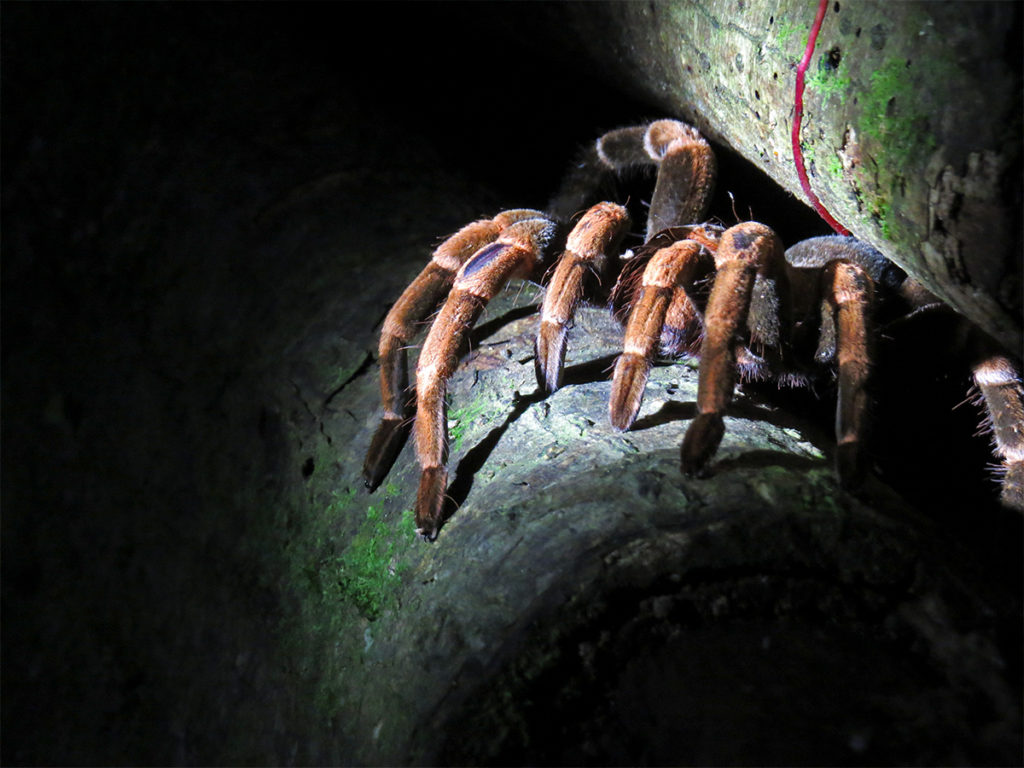
Wrapping up our list of Costa Rica animals is a creature that will either fascinate you or make you run for the hills screaming. Tarantula, or the Bird-eating spider is the largest spider in the world.
Despite its terrifying appearance, tarantula is not one of the most poisonous spiders. Its venom won’t kill a human. When I was living in Thailand, my 7 year old neighbor found a tarantula in our backyard and considered it her pet. Your best chance of spotting a tarantula is the spotlighting walk in Monteverde Cloud Forest Reserve.
Final Thoughts on Spotting Costa Rica Animals
This list of Costa Rica animals doesn’t even scratch the surface of Costa Rica’s extraordinary biodiversity. But it gives you an idea of what to expect on your travels, especially if you plan to visit a few National Parks in Costa Rica. And you really should.
Some of the best areas for wildlife watching in Costa Rica are Corcovado National Park, Tirimbina Reserve, La Selva Biologial Station, Palo Verde National Park and Tortuguero.
More on Exploring Costa Rica
- Can you see much Wildlife in Manuel Antonio National Park, Costa Rica?
- Wild Adventure of Getting to Corcovado National Park in Costa Rica
- Costa Rica’s Continental Divide and Poas Volcano
- Tirimbina Lodge: wildlife, rainforest and Costa Rica’s longest suspended bridge
- Wildlife of La Selva Biological Station, Costa Rica
- Exploring Palo Verde National Park, Costa Rica
- Whale watching in Drake Bay, Costa Rica
- Road trip: Costa Rica Wildlife & National Parks
- Surprising Wildlife of Riu Guanacaste Resort, Costa Rica
- 25 Landmarks in Costa Rica to Add to Your Bucket List

